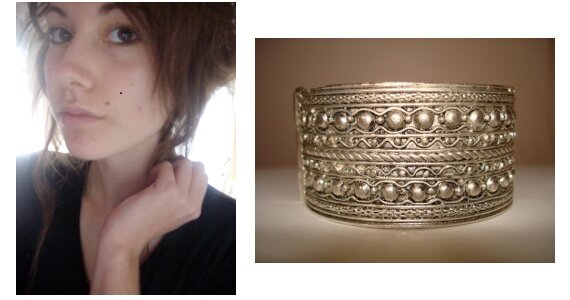The right watch, necklace, or any other kind of jewelry can set off an outfit, make a person more noticeable and even give a window into an individual’s personality. In Photoshop, we can accessorize after the fact to set a mood, or to enhance a person’s apparent personality traits–or contrast them.
We’ll demonstrate how to realistically accessorize anyone by adding a sassy silver bracelet by Visualjenna-Stock to the wrist on this stock portrait by meglillyan.  In order for our model to say it with silver, we first need to get that bracelet down to a size that will fit our portrait. We’ll go to Image/Image Size and set the width to 1000 pixels and the height to 750.
In order for our model to say it with silver, we first need to get that bracelet down to a size that will fit our portrait. We’ll go to Image/Image Size and set the width to 1000 pixels and the height to 750.  Next, we go to Selection/Select All. With the entire bracelet jpeg highlighted we then move to Edit/Copy and then, on our portrait we select Edit/Paste to transfer the bracelet to our portrait.
Next, we go to Selection/Select All. With the entire bracelet jpeg highlighted we then move to Edit/Copy and then, on our portrait we select Edit/Paste to transfer the bracelet to our portrait.  Now we need to get rid of the unwanted background from our bracelet, which is now “Layer 1.” We will go to Layer/Add Layer Mask/Reveal All. Using a soft-edged paintbrush with the foreground color set to black and the opacity set to 100%, we then zoom in and take our time removing the background from “Layer 1,” after making sure the mask space is highlighted in the Layer Palette. If we accidentally remove some of the bracelet, it’s no big deal. We simply set the foreground color to white to bring back any silver we need.
Now we need to get rid of the unwanted background from our bracelet, which is now “Layer 1.” We will go to Layer/Add Layer Mask/Reveal All. Using a soft-edged paintbrush with the foreground color set to black and the opacity set to 100%, we then zoom in and take our time removing the background from “Layer 1,” after making sure the mask space is highlighted in the Layer Palette. If we accidentally remove some of the bracelet, it’s no big deal. We simply set the foreground color to white to bring back any silver we need. 
Formfitting Style
Now that our bracelet is free of any unwanted background, we get to give our eyes a breather as we zoom back out and get ready to fit the bracelet to the model’s wrist. We use the move tool to get “Layer 1″ over the subject’s wrist. Our next step involves going to Edit/Free Transform and then we turn, twist, and form fit it. We have to make sure that first, it’s not too loose, but not too tight for the bracelet to realistically sit on her wrist where it does. Second, we can’t go crazy with the transform tool and make the detail look too stretched or overly pinched. When we contract or expand horizontally, we must do so to the same degree vertically. 
“Okay,” you tell me. “This looks sorta cool, so far, but the bottom left of “Layer 1″ doesn’t believably fit around the wrist.” Very astute! In order to seal the deal on our fit, we must go to Edit/Transform/Distort. We must be very gentle in using this tool. Remember, we don’t want the proportions too drastically altered in the bracelet’s ornate detail. We simply are going to make the bottom stretch a little bit more around the wrist. Distort lets us twist and bend any layers to ridiculous degrees, so let’s summon that patience that let us remove the background from “Layer 1″ and get to work. On the bottom corner points we’re going to gently pull them outward so the very edges of the bracelet extend slightly past the edges of her wrist. Remember, we want a close fit, but we’re not slapping cuffs on her. It shouldn’t look tight. If we have barely stretched those bottom edges it should look like something like this: 
Making Less Seem Like More
Now that “Layer 1″ fits the subject correctly, we need to make it settle in realistically as well. The portrait’s detail isn’t as sharp as that of the bracelet, and the portrait’s color is also noticeably muted. To correct this we will go to “Layer 1″ in the Layer Palette (making sure the workspace and not the mask is highlighted,) then go on to Layer/New Adjustment Layer/Hue-Saturation. After making sure we check “Use Previous Layer to Create Clipping Mask,” we move the Saturation slider down to “-70″ and drop the Lightness to “-20.” 
We managed to get the color and brightness to settle in better with the “Background” layer, but it still looks a little flat, like somebody, well… like somebody cut and pasted it on her. We’re going to fix this with some layer effects by going to Layer/Layer Style/Bevel and Emboss. We’ll take a cue from the model and remember that less is more as we choose “Inner Bevel” from the Style dropdown menu, then “Smooth” for our Technique. Depth is set at 1%, with the “Up” radio button checked for Direction. After that we move the Size slider to 5 pixels and Soften to 1 pixel. In the Shading adjustments we leave “Use Global Light” checked as well as the box next to Anti- aliased. Then we set our Highlight Mode dropdown menu to “Screen” at 45% Opacity, and our Shadow Mode to “Multiply” before moving that Opacity slider to 75%. This may not seem like a big difference at first, but if we check and uncheck Bevel and Emboss in the style menu to the left a couple times, we can see that “Layer 1″ has more depth and weight to it than before, but we’re not done yet.
We Return to Layer/Layer Style, but this time we go to Drop Shadow. As with our Bevel and Emboss effect, this will be very subdued in that we set our Blend Mode again to “Multiply.” We drop our opacity slider to 35%, Distance and Size both to 1 pixel, Spread to zero, and check the Anti-aliased box. 
“Heeeey,” you exclaim. “That looks a lot better! But the level of detail in “Layer 1″ is much sharper than that of the “Background” layer. What’s up with that?” We’re going to fix that with some filter effects.
Let’s Get Fuzzy
We go to Filter/Blur/Gaussian Blur, making sure the Preview box is checked so we know exactly how much is enough. In this case the Radius slider should be set to 3.0 pixels. 
We have matched the level of detail in the “Background” layer, and we must do the same with the noise. We return to the Filter menu and select Noise/Add Noise. Working the slider to match is easy, right next to “Layer 1,” and we drop the noise into lockstep by checking the Gaussian radio button, making sure to leave the Monochromatic box unchecked. Then we watch the noise come together by moving the Radius slider to 4.8 pixels. 
With that, we have successfully accessorized our subject. Now this unpretentious young lady is showing a hint of sass, and maybe her expression shows a hint of embarrassment at her indulgence in ornate bling. Then again, maybe she just hates having her picture taken. Who can say? 
We learned with this simple exercise that using very subtle layer effects and filters can easily help us realistically place jewelry like our silver bracelet, necklaces, and more onto people in photographs. Plus, we know that any adornments not only have to fit the person, but the color and levels of detail as well. Finally, placing such items on people can help us set a desired tone, whether in professional work or personal projects, a simple item attached to a wrist or any other part of the body can make the ordinary more intriguing, setting the viewer’s imagination in motion, and that’s what it’s all about.
Now, if you’ll excuse me, I have to remind one of my less fashion conscious friends that his next wristwatch should be stainless steel, because it goes with everything.

{ 7 comments… read them below or add one }
wow! thanks a ton for this tutorial. it will be very helpful for me in my job. thanks
No offense man, but that still looks really fake. You could have really bumped up the realism by blurring it a bit since the photo is a bit blurry and the bracelet looks too sharp, by toning down the contrast in it to coincide with the rest of the image, and to cast a bit of shadow on the arm to make it appear as if it’s in the actual 3D space of the photo and not stuck over it.
Great tutorial, I used to shy away from placing things like jewelry on subjects in post production, but after this i might have a little more courage.
raf
Thanks your article. It’s useful.
Thanks for this detailed tutorial. It’s very easy to learn and very helpful.
sell for gift with confident
Accessorize Your Pixels: Placing Jewelry with Photoshop — Spoonfed Design